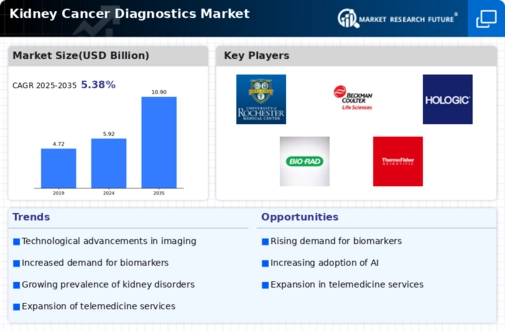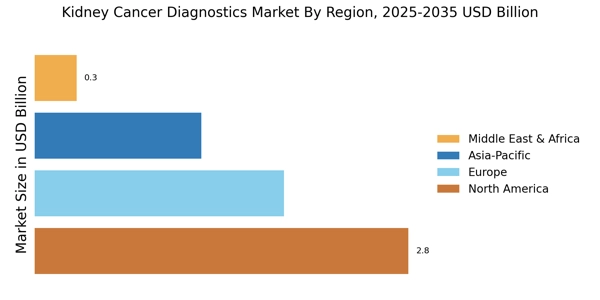Regulatory Support and Guidelines
The establishment of supportive regulatory frameworks and guidelines is fostering growth in the Kidney Cancer Diagnostics Market. Regulatory bodies are increasingly recognizing the importance of early detection and accurate diagnosis in improving patient outcomes. As a result, they are implementing policies that encourage the development and approval of innovative diagnostic tools. This regulatory support not only streamlines the approval process but also instills confidence in manufacturers and investors. Consequently, the market is likely to witness an influx of new products and technologies aimed at enhancing kidney cancer diagnostics. The alignment of regulatory initiatives with market needs is expected to create a conducive environment for growth in the Kidney Cancer Diagnostics Market.
Rising Incidence of Kidney Cancer
The increasing incidence of kidney cancer is a primary driver for the Kidney Cancer Diagnostics Market. According to recent statistics, the prevalence of kidney cancer has been on the rise, with an estimated 76,000 new cases reported annually. This surge in cases necessitates advanced diagnostic tools and technologies to facilitate early detection and treatment. As healthcare systems strive to manage this growing burden, the demand for innovative diagnostic solutions is expected to escalate. Furthermore, the aging population, which is more susceptible to various cancers, contributes to this trend. Consequently, the Kidney Cancer Diagnostics Market is likely to experience significant growth as stakeholders seek to address the challenges posed by the rising incidence of kidney cancer.
Advancements in Diagnostic Technologies
Technological innovations in diagnostic methodologies are propelling the Kidney Cancer Diagnostics Market forward. The advent of advanced imaging techniques, such as MRI and CT scans, has revolutionized the detection and diagnosis of kidney cancer. These technologies enhance the accuracy of tumor identification and staging, thereby improving patient outcomes. Additionally, the integration of molecular diagnostics and biomarker identification is gaining traction, allowing for personalized treatment approaches. The market is projected to witness substantial growth, with an estimated CAGR of 7% over the next five years, driven by these advancements. As healthcare providers increasingly adopt these cutting-edge technologies, the Kidney Cancer Diagnostics Market is poised for expansion.
Increased Investment in Cancer Research
The surge in investment directed towards cancer research is significantly influencing the Kidney Cancer Diagnostics Market. Governments and private organizations are allocating substantial funds to develop novel diagnostic tools and therapies. This influx of capital is fostering innovation and accelerating the pace of research and development in kidney cancer diagnostics. For instance, funding initiatives aimed at enhancing early detection methods are likely to yield breakthroughs that could transform the diagnostic landscape. As a result, the market is expected to benefit from the introduction of new diagnostic solutions that improve accuracy and efficiency. This trend underscores the commitment to combating kidney cancer and is anticipated to drive growth within the Kidney Cancer Diagnostics Market.
Growing Demand for Non-Invasive Diagnostic Methods
The increasing preference for non-invasive diagnostic techniques is shaping the Kidney Cancer Diagnostics Market. Patients and healthcare providers alike are gravitating towards methods that minimize discomfort and risk. Non-invasive approaches, such as urine tests and blood-based biomarkers, are gaining popularity due to their ease of use and ability to provide rapid results. This shift is likely to enhance patient compliance and satisfaction, ultimately driving market growth. As research continues to unveil new non-invasive diagnostic options, the Kidney Cancer Diagnostics Market is expected to expand, catering to the evolving needs of patients and healthcare professionals. The emphasis on patient-centered care further underscores this trend.


















Leave a Comment